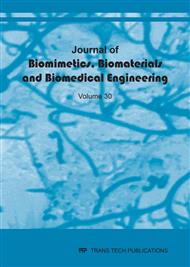p.12
p.24
p.31
p.38
p.45
p.61
p.76
p.86
p.97
Effect of Nitrogen Oxide on the Gums Lamina propria Structure and Function in the Experimental Gastritis, Duodenitis and Pharmacological Correction
Abstract:
In the conditions of experi mental chronic gastritis and duodenitis reproduction, carried out among Wistar line 24 rats, was investigated effect of the nitrogen oxide stable metabolites content in the gums homogenates on a lamina propria structure and function. Results of our research have been shown, that level of nitrogen oxide stable metabolites in the rats’ gums tissues homogenates with gastritis and duodenitis decreased in three times, compared with a same period at the intact animals, which indicated about depletion of a nitrogen oxide depot at the given disease. It was revealed a significant decrease typical for the protein and glycoprotein content in the animals gums tissues at the experimental group, which indicated about the catabolic processes predominance. Amount of hexosamines in the gums was significantly increased, which was correlated with a morphological picture (gums lamina propria impregnation with the blood plasma proteins), testified about a change in the vascular wall permeability and microcirculation disruption. In the animals from experimental group was reduced a height of gums papillae connective tissue to 27.18±1.86 x 10-6 m against 56.93±2.64 x 10-6 m in the rats from control group. In the gums lamina propria defines phenomenon of the papillary and reticular layer fibrosis. After medicamentous correction, carried out with an antioxidant and the nitrogen oxide donor was observed repairing structure of the gums lamina propria on a background of increasing microvasculature area. It was determined significantly increased protein and glycoprotein content in the gums tissues with increased levels of nitrogen oxide metabolites.
Info:
Periodical:
Pages:
86-96
Citation:
Online since:
January 2017
Authors:
Keywords:
Price:
Сopyright:
© 2017 Trans Tech Publications Ltd. All Rights Reserved
Share:
Citation:


